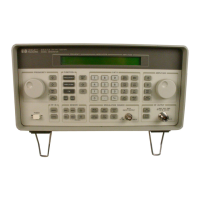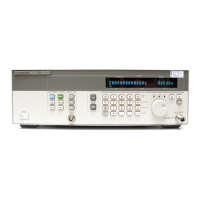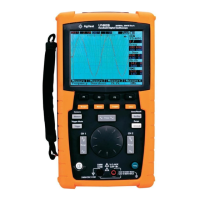7-8
Calibration Commands
OUTPut
Initiates a module calibration on a selected module, channel, or slot. For the CHANnel and
SLOT arguments, the specified value should be either 1 (left module position) or 3 (right
module position).
Whenever a calibration message is displayed on the instrument, send the :CALibrate:CON-
Tinue, :CALibrate:CANCel, or :CALibrate:SDONE commands. Sending any other command,
including *OPC, disrupts the instrument forcing you to cycle instrument power.
Example GPIB sequence for module calibration:
10 OUTPUT 707;":CALIBRATE:MODULE:VERTICAL LMODULE" <disconnect all inputs>
20 OUTPUT 707;":CALIBRATE:MODULE:CONTINUE"
30 END
OUTPut
Command :CALibrate:OUTPut <dc_value>
This command sets the dc level of the calibrator signal output through the front-panel CAL
connector.
Example This example puts a dc voltage of 2.0 V on the analyzer Cal connector.
10 OUTPUT 707;":CALIBRATE:OUTPUT 2.0"
<dc_value> dc level value in volts, adjustable from –2.0 V to +2.0 Vdc.
Query :CALibrate:OUTPut?
The query returns the current dc level of the calibrator output.
Returned Format [:CALibrate:OUTPut] <dc_value><NL>
Example This example places the current selection for the dc calibration to be printed in the string
variable, Selection$.
10 DIM Selection$[50] !Dimension variable
20 OUTPUT 707;":CALIBRATE:OUTPUT?"
30 ENTER 707;Selection$
PROBe
Command :CALibrate:PROBe CHANnel<N>
Starts the probe calibration for the selected channel. It has the same action as the command
:CHANnel<N>:PROBe:CALibrate. For more information about probe calibration, refer to
“Probe Calibration” on page 7-3. <N> is an integer, 1 through 4.
Whenever a calibration message is displayed on the instrument, send the :CALibrate:CON-
Tinue, :CALibrate:CANCel, or :CALibrate:SDONE commands. Sending any other command,
including *OPC, disrupts the instrument forcing you to cycle instrument power.
Example 10 OUTPUT 707;":CALibrate:PROBe CHANnel1"
RECommend?
Query :CALibrate:RECommend? {CHANnel<N>}
